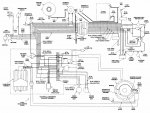Matthew70'sGlastron
Cadet
- Joined
- Jun 6, 2016
- Messages
- 21
I recently acquired a Glastron boat with a 70's model Johnson 115. The first issue I noticed was the tach was not working and the battery was not being charged. After wiring inspection I found that the rectifier was corroded and bad. I purchased a new one and installed. Boat started fine and I proceeded to adjust low speed idle over the next few days. On the latest startup I noticed that it kicked itself into gear so I turned it off quickly pulled the engine cover and smelled something electrical. After inspection I noticed my clipper circuit had failed. which may or may not have caused an overvoltage to my lower unit solenoids failing the upper one. Can someone shed some light on this issue??




















